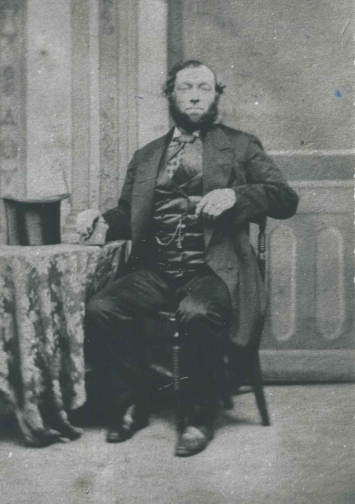I first came upon John Errington, Inspector of Nuisances, while researching our cowkeeper ancestor, periodically charged with diluting milk and keeping his cows in a filthy state. It was Errington’s job to sniff out unsanitary conditions in one of the poorest parts of Victorian London, so he was a busy man. When he discovered rancid cherries and rotten mackerel being sold in the streets, he delivered the foul evidence to the Medical Officer of Health. Together these men were part of a team looking out for the community’s welfare in a time when the spread of disease wasn’t fully understood, and dirt and grime were abundant. More than once, the “intolerable effluvium” Errington investigated emanated from bodies left unburied. Poverty was frequently at the core of his work.

In June 1876, he deemed a block of houses in Glasshouse Yard, Gravel Lane, unfit for human habitation. Filth alone was enough to condemn them for “danger of fever,” but they looked structurally unsafe, too, so Errington called upon surveyor Thomas Greenstreet, who likewise condemned the houses. Bits of roof had come away; shutters, flooring and banisters had been torn out for firewood. The tenants were mostly poor Irish families, and though the property owner, the South Eastern Railway Company, had evicted them, they stayed, having nowhere else to go. The company had purchased dilapidated housing in order to knock it down and expand a railway line, but not all of the property had been required, and these were the places left over, some of them missing doors and windows.
In July, one of the houses fell. Fortunately, no one was inside, but the Medical Officer of Health, Robert Bianchi, warned that the other houses were now even more precarious, and might “tumble down at any hour.” He urged “immediate ejectment of the tenants on humanitarian grounds.” Greenstreet recommended that, until the buildings were demolished, a hoarding be erected around the perimeter.

By August, though, the houses remained, and with no barrier. A widow named Julia Hunter was at home in another of the illegally inhabited dwellings when she heard a huge crack and saw the walls of the house next to the fallen one give way. The walls fell outwards in pieces, and the roof crashed down. It was a startling sight, but not shocking, for Julia had expected it, and had warned her children not to play near those houses. At least, once again, no one had been inside. Or so it was thought.
Julia’s son told a friend about the house that fell down, and he came to see the destruction. He was picking through the rubble when he spotted a tiny pair of shoes sticking up, toes to the sky. The deceased was John David Evans, two-year-old son of a dairyman living nearby. The boy was taken to the infirmary, but “life had ceased to exist for several hours.” The doctor noted John’s body was covered with bruises, his jaw had been forced in, and his right eye protruded. “Death ensued from suffocation.”
One article claims that, after the tragic collapse, “a number of gentlemen interested in the case proceeded to the Glasshouse-yard … for the purpose of viewing the scene of the disaster. A number of families were found huddled together, and the scanty furniture and bedding were packed up and deposited for hasty removal in the yard.”
By the time of the inquest a week later, four more of the rickety houses had already been pulled down. But there were plenty of similar dwellings in the vicinity, so the tavern where the inquest was held was “crowded to excess … the case having created great interest in the neighbourhood.” Errington testified as to the homes’ squalor, and the danger of disease, and Greenstreet noted that “a heavy gust of wind would have blown them down.” The incredulous coroner asked Julia Hunter, “Why did you remain?” and she answered, “It was impossible for us to get any other place to dwell in. One of our neighbours, a decent woman, has been trying her hardest to get a place, but can’t do it, because the police have given us all such a bad name, because we are Irish.”
The coroner deemed the death accidental in the end, and said that even if there had been criminal negligence, no verdict of manslaughter could be made against corporate bodies like the Board of Works and the railway company. But he added a rider: “the Metropolitan Board of Works should have taken immediate steps towards securing the house that fell upon receipt of the notice … from the surveyor, Mr. Greenstreet.”
But a year later, some of the buildings remained standing, unsecured. And elsewhere in the neighbourhood, the same problems prevailed. Just a few months after John Evans’ death, the tireless Inspector Errington implored the Magistrate to remember the little boy and the tumbling houses in Glasshouse Yard: another 16, also owned by the railway, were teetering in Ewer Street, fully inhabited, emptied of woodwork, and open, in places, to the sky.

♦
Sources
“Law and Police – Southwark.” South London Chronicle, 17 June, 1876.
“Items of General News.” The Western Morning News, 17 August, 1876.
“Shocking Case.” Yorkshire Post and Leeds Intelligencer, 24 August, 1876.
“Fatal Fall of a House.” South London Chronicle, 26 August, 1876.
“Fatal Fall of a House.” Reynolds’s Newspaper, 26 August, 1876.
“Fall of a House in Southwark.” Salisbury Times, 19 August, 1876.
“Dilapidated Houses in Ewer-street, Southwark.” South London Chronicle, 11 November, 1876.


